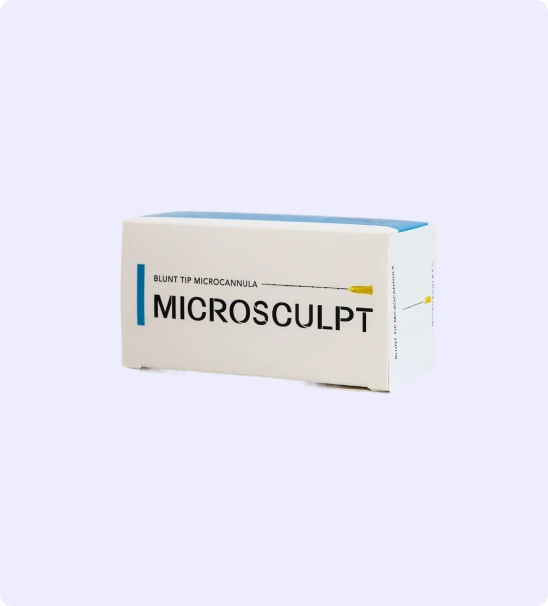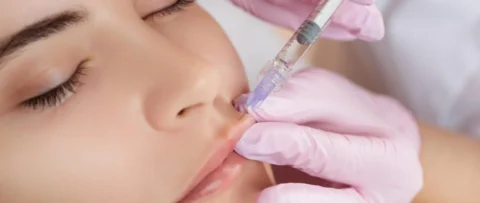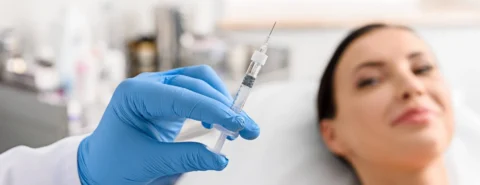In a recent study conducted by The People’s Republic of China, multiple doctors tested various types of microcannulas to measure their differences and effectiveness. Let’s dive into what the study talked about and how they came to the conclusions that they did.
Why A Study On Microcannulas?
Soft-tissue augmentation is a mainstay of cosmetic enhancement for the face and has grown immensely in popularity. The American Society for Aesthetic Plastic Surgery has a long list of used filler types. They are calcium hydroxyapatite, collagen, fat, hyaluronic acid, polylactic acid, and polymethylmethacrylate microspheres. That’s a long list of choices, but of all these unique types of fillers, hyaluronic acid is used the most.
Why? Because of its hygroscopic properties, biocompatibility, and reversibility, hyaluronic acid is viewed as the most common dermal filler with which to restore volume loss.
Hyaluronic acid injection complications are local injection-related side effects that manifest as edema, pain, bruising, erythema, itching, and ecchymosis; the most concerning difficulty is vascular occlusion. It doesn’t sound too appealing at first. However, blunt-tipped can provide some reassurance.
Hyaluronic acid gels can be injected using sharp needles or blunt microcannulas. Studies have shown that the blunt microcannula with a side port presented improvements in mitigating pain and adverse effects, which has a degree of correction similar to a needle.
Some scholars state that the use of the microcannula is ideal for deeper nasolabial fold and lip augmentation and in areas requiring a larger filler volume, such as the mid-face and jowl regions.

INJECTIONS YOUR PATIENTS WILL LOVE! CODE “20OFF” TAKES 20% OFF YOUR FIRST ORDER!
Microcannulas are a tool that every great injector must master. Patients want quick results with no downtime. Our microcannulas are high quality and a fraction of the price of our competitors!
You can create an account here.
The Differences Between Microcannulas
It’s clear that micro cannulas have superior results compared to sharp-tipped needles, but which microcannulas work the best?
Microcannulas’ use is limited by the injection area and the physician’s choice, but the differences between microcannulas constructed by different manufacturers have not been carefully investigated.
This study was designed to compare the microstructures and properties of different microcannulas by several trials and provide guidance for clinical application.
Materials
The study chose nine types of microcannulas that are widely used internationally. These microcannulas are available in gauges ranging from 18 to 30; the 23-, 25-, and 27-gauge. All microcannulas have a blunt tip with a precision laser-cut lateral side port for filler extrusion and a plastic pedestal that fits on any Luer lock syringe.

The physician may choose a different gauge or length because of the requirements of injection, including the technique being used and the area being filled.
In this study, all microcannulas are 25-gauge.
Methods
Scanning Electron Microscopic Images of the Microcannulas.
The microcannulas were sectioned and mounted onto a stub. A scanning electron microscope was used to obtain a high-definition image of the blunt tip, side injection port, and inner surface through each microcannula’s side port. For each microcannula, three new microcannula tips were measured.
The Results
The microcannulas had various tip shapes. The microcannula’s hole was oval (microcannulas 1, 3, 4, 5, 6, and 7), pointed rounded (microcannulas 8 and 9), or a unique form (similar to the rounded trapezoidal structure) (microcannula 2).
The ports of the Microcannulas were mainly oval, but the lengths were different, and some ports were three times larger than the others. There were two port edge forms; some (microcannulas 1, 2, 3, 4, 5, 6, and 7) were smooth, and others (microcannulas 3, 8, and 9) were rough. The edge form depends mainly on the technical process, and the laser cutting generally results in a smooth shape.10 For the inner surface, most microcannulas (1, 2, 3, 4, 5, 6, 7, and 8) had inner surfaces with a cord-like structure; only microcannula 9 had an oval structure inner surface, and the difference demonstrated that they had different surface processes.
Material
The inner surfaces of some microcannulas (2 and 8) had visible impurity, and the exterior of microcannula 7 had a stripe-like structure.
Only microcannulas 1 and 9 met the requirement concerning carbon composition; the other microcannulas had a higher composition with a significant difference. For other elements, all microcannulas met the American Society for Testing and Materials requirement; microcannula 9 was the only one that fits the American Society for Testing and Materials composition standards for all elements.
Elasticity
The elastic moduli of microcannulas 2 and 7 are smaller than those of other microcannulas. The yield strength was analyzed; the yield strength of microcannula 9 was the highest. There was a significant difference in the mechanical properties among the microcannulas.
Injection Speed
Microcannula 1 had the highest speed compared with other microcannulas, and microcannula 9 was the slowest one in the test. The difference in the time spent between microcannula two and microcannula 9 was more than 7-fold.
The result of the injection force test showed that some microcannulas could easily puncture the aorta with a higher force; it was difficult for microcannula 4 to puncture the aorta.
INJECTIONS YOUR PATIENTS WILL LOVE! CODE “20OFF” TAKES 20% OFF YOUR FIRST ORDER!
Microcannulas are a tool that every great injector must master. Patients want quick results with no downtime. Our microcannulas are high quality and a fraction of the price of our competitors!

What Does This Mean For Microcannulas?
Compared with the traditional sharp needle, there is a definite advantage for blunt microcannulas to reduce patient discomfort, bleeding, and bruising, attributable to its rounded tip.
In the electron microscopy results, there are nine types of microcannulas, which are mainly oval, pointed, or rounded, and microcannula 2 exhibits a unique form. From the point of stress, it is microcannulas 2, and 7 show significant differences with others.
It was more comfortable for the sharper microcannulas to penetrate the tissue, and the patient may feel more comfortable. By contrast, when blunt microcannulas meet dense tissue, such as ligaments and fascia, there will be a certain degree of discomfort from the tissue shift caused by the resistance. However, a blunter microcannula has a lower probability of piercing the vessels and is therefore safer.
This issue is further investigated in the vessel piercing test. The results show that the tips of microcannulas 2, 8, and 9 are sharper, and the others are blunter.
For microcannulas 2 and 8, the carbon content is higher than the American Society for Testing and Materials standard level, and the carburizing treatment of the microcannula surface is mainly considered. Carburizing treatment is a chemical heat treatment process in which the steel is put into the carburizing medium to be heated and preserved, making the carbon atoms enter the surface.
Generally, the surface carbon content increases with increases in the carbon atmosphere concentration, diffusion time, and diffusion temperature, whereas the internal carbon content is less affected. As the carbon content increases, the hardness and wear resistance of the material is often higher, as is the brittleness. The plasticity and toughness are worse, which may lead to a fracture in bending and stretching deformation. Microcannula 9 is the only one that fully conforms to American Society for Testing and Materials standards.
Importance for Doctors
It is essential for physicians to feel the injection during the operation; therefore, the study designed an injection speed experiment that was aimed at determining the time of each microcannula injection, and the volume of hyaluronic acid under constant pressure indirectly reflected the smoothness of the operative process. Smoothness is related to the inner diameter and the smoothness of the inner wall.
From a fluid mechanics standpoint, all other things being equal, the time spent for the liquid to pass through a microcannula depends on the larger area of the inner section and the side port section. When the inner part is larger than the side port section, the outflow of liquid is restricted by the side port, and the inner diameter makes no difference and vice versa.
For microcannulas 1, 2, 3, 5, 7, 8, and 9, the inner section is larger than the side port section, and, along with the reason for differences in smoothness, the result of injection speed can be explained. When changing between different microcannulas, physicians should be fully aware of the smoothness of different microcannulas. They should first adapt to the actual injection handle and then inject to avoid making the injection volume too large or too small. Although injection technology of hyaluronic acid has become increasingly mature, complications are frequent.
One of the most serious is the microcannula piercing the blood vessels, which can lead to vascular embolization. There have been many cases of embolism reported in the literature that have resulted in skin necrosis and blindness. A competent physician must, as much as possible, reduce the risk of vascular embolism to zero. On the one hand, we should be familiar with the anatomical structure of different injection areas to avoid blood vessels during the injection.
On the other hand, it is also imperative to choose a suitable injection tool. A few studies have shown that the microcannula with a blunt tip is better for avoiding punctured blood vessels than a sharp tip. The results showed that microcannula 4 struggled the most to penetrate the blood vessels, and the relative safety was high.
If you’re a doctor who wants to purchase microcannulas, then explore FACE Medical Supply’s store for all our available microcannulas. We carry multiple sizes to suit whatever your needs are.
Reference for Summary
Comparison of Microstructure and Properties of Different Microcannulas for Hyaluronic Acid Injection.
-
 23 gauge 50 mm (2 inch) Microcannulas
23 gauge 50 mm (2 inch) Microcannulas -
 22 Gauge 100 mm (4 inch) Microcannulas.
22 Gauge 100 mm (4 inch) Microcannulas. -
 27 Gauge 38 mm (1.5 inch) Microcannulas
27 Gauge 38 mm (1.5 inch) Microcannulas -
 25 Gauge 38 mm (1.5 inch) Microcannulas
25 Gauge 38 mm (1.5 inch) Microcannulas -
 30 Gauge 25 mm (1 inch) Microcannulas
30 Gauge 25 mm (1 inch) Microcannulas -
 18 Gauge 100 mm (4 inch) Microcannulas
18 Gauge 100 mm (4 inch) Microcannulas -
 25 Gauge 50 mm (2 inch) Microcannulas
25 Gauge 50 mm (2 inch) Microcannulas -
 21 Gauge 50 mm (2 inch) Microcannulas
21 Gauge 50 mm (2 inch) Microcannulas -
 21 Gauge 70 mm (2.75 inch) Microcannulas
21 Gauge 70 mm (2.75 inch) Microcannulas







